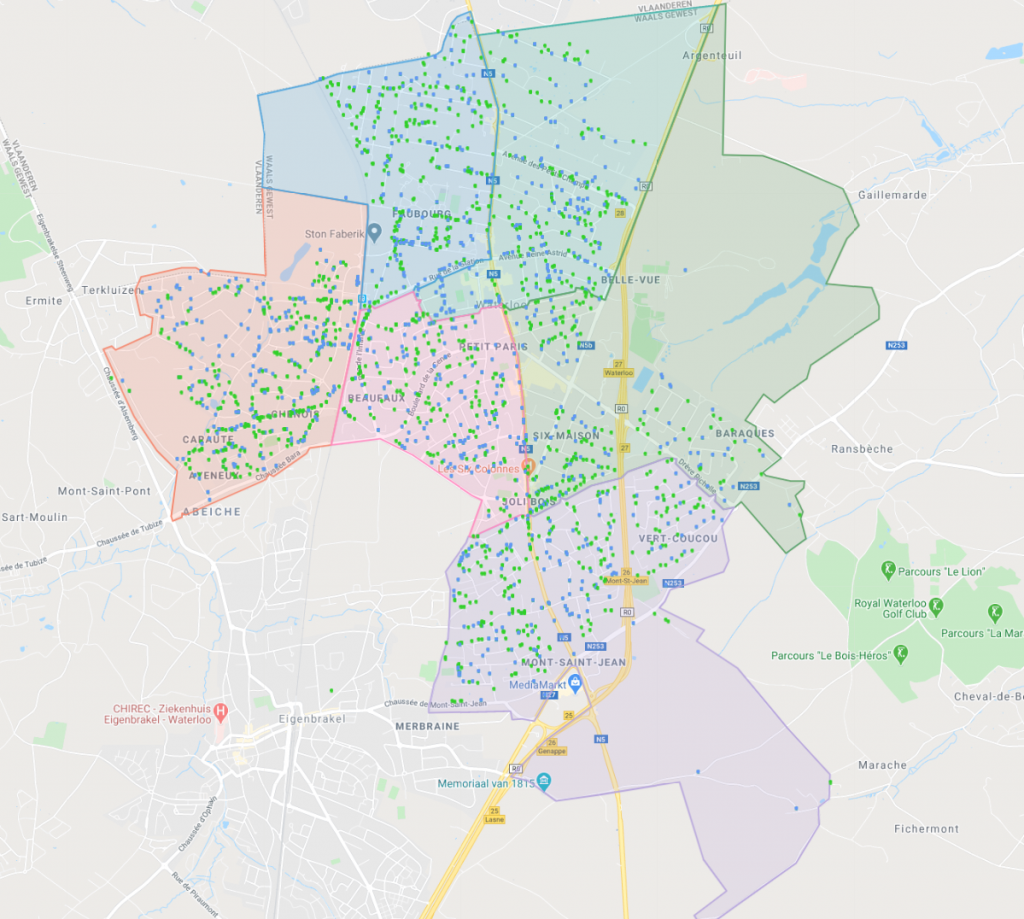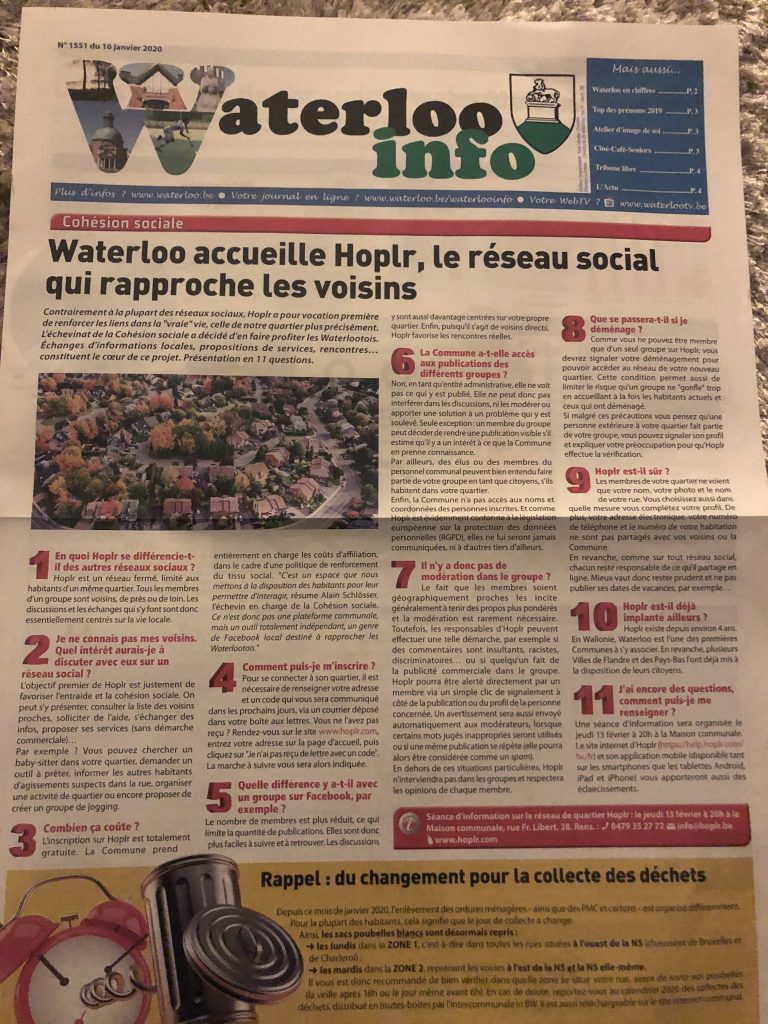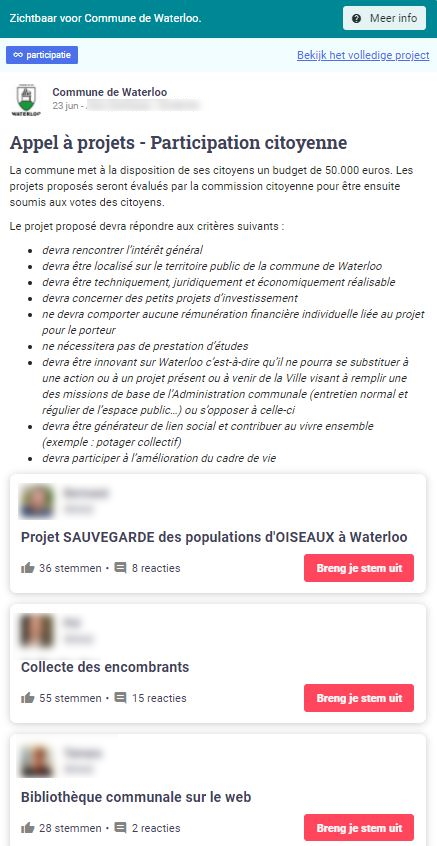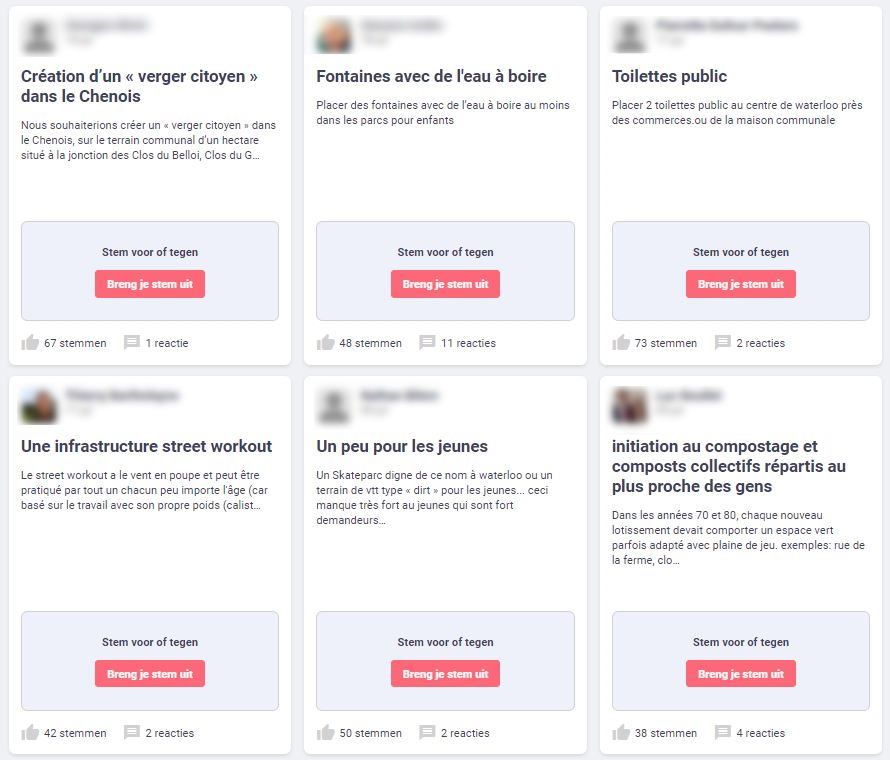CASE STUDY: Waterloo community building pioneer of Wallonia with Hoplr
In 6 months time, more than 2,280 households (21%) registered for one of the 6 Hoplr neighbourhoods that were launched in Waterloo in early January 2020. Neighbours post an average of 72 neighbourhood messages and 639 comments per week, which now amounts to a total of more than 50,000 interactions. 81% of registered households use Hoplr at least once a week.
In this article you will read:
- what the municipality of Waterloo aims to achieve with Hoplr
- what the collaboration with Hoplr looked like
- what the results were after 6 months
- how the municipality of Waterloo uses Hoplr to mobilise the community

1. Objectives of the municipality of Waterloo
The board’s ambition for the launch of Hoplr is twofold.
- The Municipality of Waterloo wants to be connected to its local communities. On the one hand to be able to share relevant information with citizens. And on the other, to invest in citizen engagement. Besides tools for both these objectives, the Service Dashboard provides municipalities with a great deal of anonymised and aggregated data, allowing them to quickly identify trends and problems in the neighbourhoods.
- However, what really excited the congregation, was Hoplr’s functionalities for community building. By digitally uniting neighbours and stimulating physical encounters, we increase the sense of community and involvement.
2. How are the neighbourhoods launched?
The Municipality of Waterloo issued a public tender for this contract. After being awarded to Hoplr, our team immediately got to work. From mapping out the neighbourhoods to promoting the digital neighbourhood network; we left nothing to chance.
Step 1: Design neighbourhoods
- In consultation with the board, we divided the territory into 6 neighbourhoods. An ideal neighbourhood consists of 1,000 to 4,000 households and often corresponds to a city center, a village, a residential area,… They reflect the existing communities as much as possible.
- We draw up a physical invitation letter with the logo of the municipality. This invitation letter has a code that allows citizens to sign up for the correct neighbourhood based on their address. Hoplr takes care of printing and distribution.

Blue – organic login without code
Step 2: Distribution invitation letters
The timing of the distribution is essential. In the case of Waterloo, we waited for the municipal newspaper to publish an article about the arrival of Hoplr.
By the time distribution started, exactly three days later, some citizens had already registered (which is possible without a neighbourhood code). This showed the neighbourhoods’ excitement, and it put some word of mouth in motion. This had a positive effect on recognition and trust, for when the letters dropped in the city’s mailboxes.

Step 3: Information session for citizens
We organised an information session for the citizen in collaboration with the municipality. In it, our Gaële explained how Hoplr works, what the house rules are,… And above all, she was there to answer the citizens’ questions and concerns. For example, a citizen wanted to know how we process personal data.
The information session in Waterloo attracted about a hundred people. For 2 hours, we exchanged questions and ideas in a friendly atmosphere.

Step 4: Service Dashboard
During an online information session, we’ll show you the ropes of the Service Dashboard.
We’ll kick off with a first status update on the Hoplr neighbourhoods (how many households are registered, how active are they on the network, how is the network being used,…).
Then, we’ll show you the different modules of the Service Dashboard and how you can use them for inclusion and neighbourhood care, citizen communication and participation. Each of these three pillars are supported by an expert who can be called upon by the municipality.
Finally, we’ll inspire you with some communication examples from other cities and set you up with a first message to post in the connected Hoplr neighbourhoods.
3. Results of Hoplr in Waterloo
After 6 months, 2,280 households from Waterloo had registered, which equals 21%. On average, 100 households register each month still, which shows continued organic growth.
Interactions between citizens
Citizens have posted 5,600 messages since launch and are continuing to post 100 neighbourhood messages and 660 responses every week. 81% of users log in at least once a week. 73% has actively contributed to the conversation, while others have merely followed along so far. Altogether, Hoplr has generated over 50,000 interactions among the citizens of Waterloo. This equates to an average of 22 interactions per household.

Messages mainly revolve around circular and local economy, contact with neighbourhoods, and ecology – however, these hot topics are different for every Hoplr neighbourhood. Our Service Dashboard uses AI to determine the topic of each message. This way, The Hague can collect a lot of interesting data, without having to access any of the Hoplr neighbourhoods or the conversations that take place there.

Hoplr stimulates offline interactions as well. This much we can tell about the first six months (three of which during lockdown): users have organised 100 neighbourhood activities, to which 519 neighbours responded they were interested and 217 said they would attend.
A survey also found that 42% of users in Waterloo had already met at least one neighbour thanks to Hoplr.

From citizen to local government
Not only can members of the local communities direct their messages to each other, but to the staff of the Municipality of Waterloo as well. These are bottom-up messages.
Citizens can use this option either to share a report, help request or idea. In Waterloo, citizens had shared many of these messages by the sixth months after launch, such as reports about left behind waste or an attempted burglary.
Finally, through the neighbourhood care functionalities, citizens may indicate they wish to be contacted by the local government regarding volunteering opportunities. Already, the municipality can count on 22 community members for neighbourly help.
From local government to citizen
Local authorities can communicate directly with the connected neighbourhoods, through the Service Dashboard. This allows them to publish different messages, such as alerts, activities, and neighbourhood polls, in one, some, or all neighbourhoods.
So far, the Municipality of Waterloo has posted 20 “external” messages on Hoplr. Topics include corona measures, mobility and services.
Anonymous survey
With the Service Dashboard, the local government has a plethora of citizen engagement functionalities at its disposal. As such, the municipality of Waterloo has already made good use of its anonymous survey to ask citizens about their experiences with Hoplr so far.
The municipality shared the questionnaire with all 2490 registered citizens. As of today, halfway through the term of two months, 473 users have already participated. This equates to a response rate of 19%.
Call for citizens’ initiatives
The best results, however, stem from a dynamic between both parties: the local government offers citizens a platform and support to take matters into their own hands.
That is exactly what the Municipality of Waterloo did with its call for citizens’ initiatives. In mid-June, the municipality published a participation project in the six neighbourhoods.
In it, they invited citizens to share ideas and initiatives that positively impact the community. Users could vote and comment on each other’s ideas. The Municipality of Waterloo made a budget of € 50,000 available for the best proposals.

In just a few weeks time, citizens had shared over 30 proposals for the community. Neighbours had voted more than 1,000 and commented 235 times on each other’s ideas.

Not only was the engagement with the project high, the conversation was incredibly positive and constructive. This does not mean that all proposals scored equally well, however. On average, an idea got 33 votes and a score of 92,3%
The neighbourhood discussion led to increased awareness within the local communities, and hopefully a number of fun projects next year!





